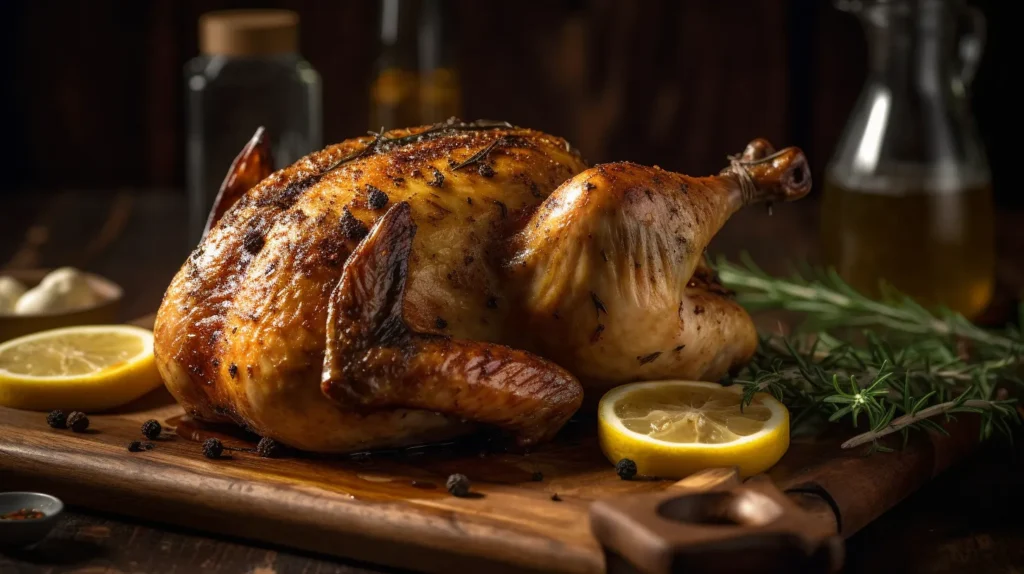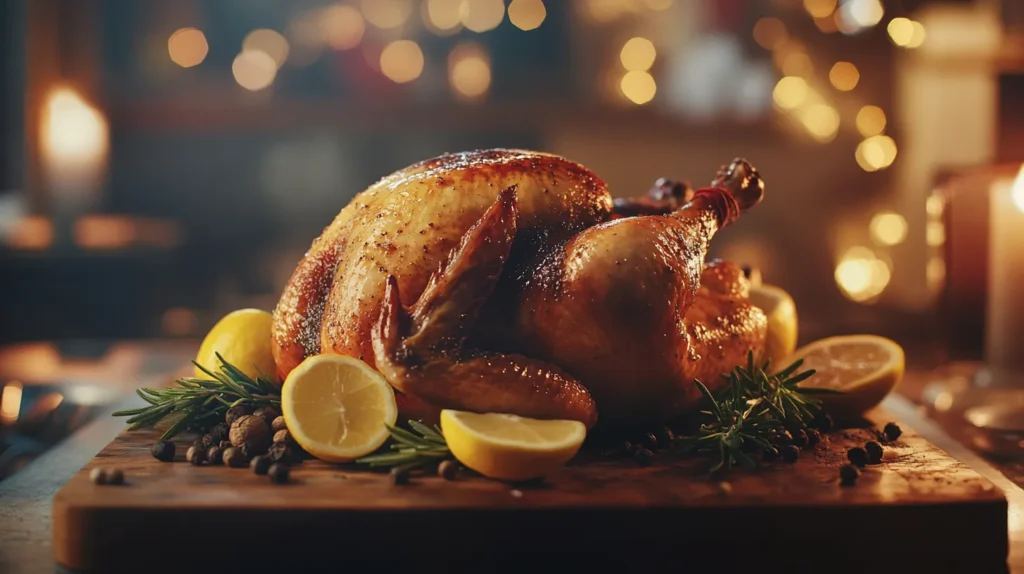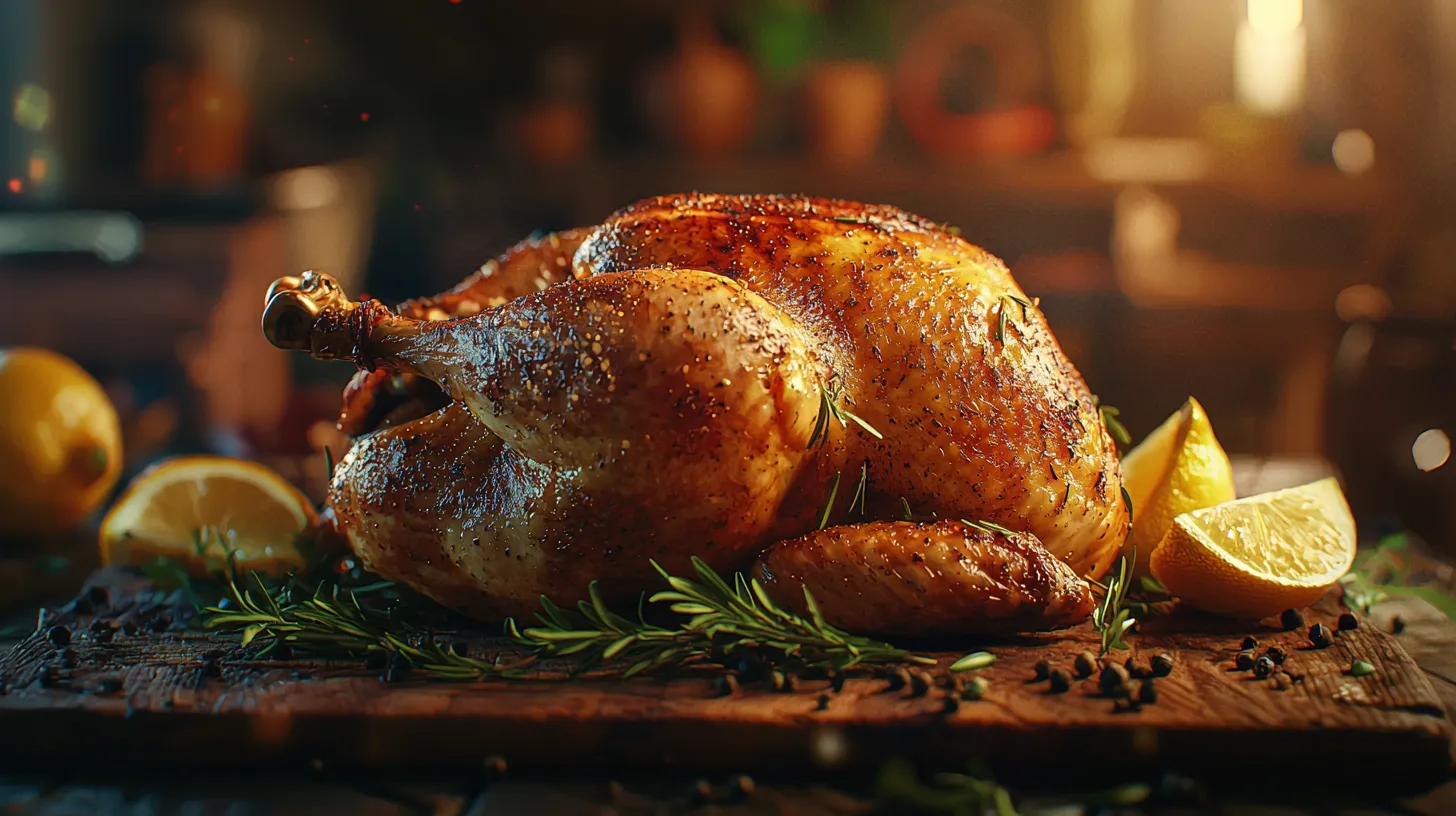When it comes to roasting chicken, the age-old debate remains: Is it better to roast chicken fast or slow? Some chefs swear by high heat for a crispy golden skin, while others prefer a low-and-slow method to ensure juicy, tender meat. But which method truly delivers the best results?
Understanding the science of roasting chicken can help you make the right choice based on your cooking goals, time constraints, and flavor preferences. In this guide, we’ll break down the advantages and disadvantages of fast and slow roasting, discuss optimal temperatures, and share expert tips to ensure your chicken turns out perfect every time.
For food safety, it’s crucial to ensure your chicken reaches the USDA-recommended internal temperature of 165°F (74°C). Additionally, understanding the science behind roasting meat can help you achieve maximum tenderness and flavor development.
Let’s dive in and explore which roasting method is best for you!

The Science of Roasting Chicken
What Happens When You Roast Chicken?
Roasting chicken is a dry heat cooking method that enhances flavor and texture by triggering the Maillard reaction—a chemical process responsible for deep caramelization, rich brown color, and complex flavors in roasted foods. This reaction occurs when proteins and sugars in the chicken break down under heat, creating that crispy, golden exterior we all love.
However, the roasting temperature you choose plays a crucial role in how this process unfolds:
- High-heat roasting (400°F-450°F): This method rapidly browns the skin, resulting in a crispy, golden crust while sealing in juices. It’s ideal for small chickens or when you need a quick, flavorful meal in under an hour.
- Low-heat roasting (250°F-325°F): Cooking at lower temperatures allows the fat to render slowly, keeping the meat tender, juicy, and evenly cooked. This method is best for larger birds or when you want deep, well-developed flavors over a longer period.
Each technique has distinct benefits and drawbacks, making it essential to understand which method works best for your cooking goals. Whether you prioritize extra crispy skin or fall-off-the-bone tenderness, your choice of roasting temperature will determine the final result.
Fast Roasting: The Benefits & Drawbacks
What Is Fast Roasting?
Fast roasting refers to cooking chicken at higher temperatures, typically between 400°F and 450°F (205°C-230°C). This method is popular among home cooks and professional chefs because it produces crispy skin and significantly reduces cooking time.
Since high temperatures quickly brown the chicken’s surface, this technique is ideal when you’re short on time or want a deeply roasted, golden-brown appearance without waiting for hours. It works best for smaller chickens (3-4 lbs) because they cook more evenly at high heat. However, fast roasting requires careful temperature control and precise timing to prevent overcooking and drying out the meat.
✅ Benefits of Fast Roasting
Fast roasting offers several advantages, particularly for those who prefer a crispy texture and bold flavors while keeping preparation time minimal.
1. Extra Crispy Skin
The high heat quickly evaporates surface moisture, allowing the skin to crisp up beautifully. Within 45 minutes to an hour, the chicken develops a golden-brown crust that is crunchy, flavorful, and deeply caramelized. This is perfect for those who love crispy roasted chicken with a rich, roasted aroma.
2. Faster Cooking Time
One of the biggest benefits of fast roasting is the reduced cooking time. While slow roasting can take several hours, fast roasting allows you to cook a whole chicken in under an hour. This makes it an excellent choice for weeknight dinners, last-minute meal prep, or when entertaining guests without long waiting times.
3. Enhanced Flavor Through Caramelization
The intense heat triggers the Maillard reaction, which deepens the flavors of the chicken by creating rich, roasted, slightly smoky notes. This results in a more pronounced, oven-roasted taste that pairs well with bold seasonings and spice rubs.
💡 Tip: To maximize flavor, rub the chicken with olive oil or butter and season it with salt, pepper, garlic powder, and paprika before roasting.
❌ Drawbacks of Fast Roasting
While fast roasting has many advantages, it also has some downsides that can impact the overall quality of the chicken, particularly when dealing with larger birds or certain cuts.
1. Higher Risk of Drying Out
Cooking at high temperatures can cause the moisture inside the chicken to evaporate too quickly, leading to drier breast meat. Since chicken breasts cook faster than thighs and drumsticks, they often become overcooked and tough before the darker meat reaches the right temperature.
💡 Tip: To prevent dryness, consider basting the chicken with butter or pan juices every 15-20 minutes or using a marinade to lock in moisture.
2. Uneven Cooking in Larger Chickens
Fast roasting is best suited for smaller chickens (3-4 lbs) because larger birds cook unevenly at high temperatures. The outside can brown too quickly while the inside remains undercooked—particularly in the thighs and drumsticks, which take longer to reach the safe internal temperature of 165°F (74°C).
💡 Tip: If using fast roasting for a larger bird, consider spatchcocking (butterflying) the chicken to ensure even heat distribution.
Slow Roasting: The Benefits & Drawbacks
What Is Slow Roasting?
Slow roasting involves cooking chicken at lower temperatures—typically 250°F to 325°F (120°C-165°C)—for an extended period. This method is perfect for large chickens or meal prepping.
✅ Benefits of Slow Roasting
- Extremely Tender Meat: The slow breakdown of collagen results in fall-off-the-bone tenderness.
- Even Cooking: The gentle heat prevents the breast from drying out, ensuring moist, flavorful meat throughout.
- Deep, Rich Flavors: The longer roasting time allows seasonings and natural juices to fully develop.
❌ Drawbacks of Slow Roasting
- Longer Cooking Time: A whole chicken may take 3 to 5 hours, requiring patience and planning.
- Less Crispy Skin: Since the fat renders slowly, the skin may not crisp up as much as with fast roasting. However, finishing at high heat can help fix this issue.
For a step-by-step slow roasting guide, check out the ultimate slow-roasted chicken recipe to master this technique.
Side-by-Side Comparison: Fast vs. Slow Roasting
| Factor | Fast Roasting (400°F-450°F) | Slow Roasting (250°F-325°F) |
|---|---|---|
| Cooking Time | 45 min – 1 hour | 3 – 5 hours |
| Skin Texture | Extra crispy | Lightly crispy (can be crisped at the end) |
| Meat Texture | Can be slightly dry | Juicy, tender, and fall-off-the-bone |
| Flavor Development | Bold, roasted taste | Deep, well-infused flavors |
| Best For | Quick meals, smaller chickens | Large chickens, meal prep, extra tenderness |
Which Roasting Method Should You Choose?
The best roasting method depends on your time, preference, and the size of the chicken. While fast roasting provides a quick, crispy meal, slow roasting ensures tender, juicy meat with deep flavor development. Each method has its own advantages, making it important to choose the right approach based on your needs.
🔥 Choose Fast Roasting If You:
✅ Need a quick, delicious dinner in under an hour
Fast roasting is ideal for busy weeknights when you need a flavorful meal without spending hours in the kitchen. At high temperatures (400°F-450°F), a whole chicken cooks in 45 minutes to an hour, making it the perfect choice for quick and efficient cooking.
✅ Prefer extra crispy skin
The high heat rapidly removes moisture from the chicken’s surface, allowing the skin to crisp up beautifully. If you love deep golden-brown, crackly skin, fast roasting will deliver that perfect crunch every time.
✅ Are cooking a smaller chicken (3-4 lbs)
Smaller chickens cook more evenly at high temperatures. Since they require less time in the oven, fast roasting ensures the breast stays juicy while the skin crisps up perfectly.
💡 Best for: Weeknight meals, smaller birds, and those who love extra crispy skin!
🐓 Choose Slow Roasting If You:
✅ Want super tender, juicy chicken
Slow roasting locks in moisture and allows the collagen in the meat to break down gradually, resulting in fall-off-the-bone tenderness. If you prefer melt-in-your-mouth chicken, this method is ideal.
✅ Have time to let the flavors develop fully
Cooking at a lower temperature (250°F-325°F) for several hours enhances the natural flavors of the chicken, allowing the seasonings and aromatics to infuse deeply. The result is rich, well-developed taste with incredibly juicy meat.
✅ Are cooking a larger bird (5 lbs or more)
Larger chickens benefit from slow roasting because the lower heat allows even cooking without drying out the breast. This is especially helpful for holiday meals or family gatherings, where you want perfectly cooked meat throughout.
💡 Best for: Large birds, meal prep, and when you want maximum juiciness and flavor!
💡 Want the Best of Both Worlds? Try the Hybrid Method!
If you want crispy skin AND juicy, tender meat, the hybrid roasting method is the ultimate solution! This two-step technique combines the benefits of slow cooking with a high-heat finish for the best possible results.
✅ Step 1: Start slow at 275°F
- Roast the chicken at 275°F for 2-3 hours, depending on size.
- This allows the meat to cook gently and retain maximum moisture.
✅ Step 2: Finish hot at 425°F for 15 minutes
- Increase the oven temperature to 425°F for the last 15-20 minutes.
- This crisps up the skin beautifully while keeping the inside perfectly tender and juicy.
This hybrid approach works well for any size chicken and provides the best balance of texture and flavor.
Final Thoughts: Which Method Should You Pick?
- For quick, crispy results → Choose fast roasting
- For ultra-juicy, tender meat → Choose slow roasting
- For the best of both worlds → Use the hybrid method
Regardless of the method you choose, roasting chicken is one of the most satisfying ways to cook poultry. Want to explore more techniques? Check out this slow-roasted chicken guide to master the perfect slow roast every time! 🚀

FAQs: Everything You Need to Know About Roasting Chicken
1. Is Slow Roasting Chicken Safe?
Yes! As long as the chicken reaches 165°F (74°C) internally, slow roasting is perfectly safe. Using a meat thermometer ensures accuracy.
2. How Do You Keep the Skin Crispy When Slow Roasting?
To get a crispy finish, increase the oven temperature to 425°F for the last 15-20 minutes.
3. Can You Combine Both Methods?
Absolutely! Start slow at 275°F, then finish at 425°F for crispy skin while keeping the meat moist.
4. Should You Baste Chicken While Roasting?
For slow roasting, basting every 30 minutes helps keep the meat extra juicy. However, with fast roasting, too much basting can prevent crisping.
5. How Can You Reheat Slow-Roasted Chicken Without Drying It Out?
Reheat at 300°F for 15 minutes, covered with foil, to retain moisture.
Final Thoughts: Which Roasting Method Wins?
At the end of the day, choosing between fast and slow roasting depends on your preferences. If you want a quick meal with crispy skin, go for fast roasting. However, if you prioritize tender, juicy meat and deep flavors, slow roasting is the better option.
For more cooking inspiration, check out these guides:
- Healthy Instant Pot Whole Chicken Recipes – A great alternative for quick, tender chicken.
- Gluten-Free Meals Guide – Perfect side dishes for your roasted chicken.
Now, it’s time to get roasting! Will you choose fast or slow? Let us know in the comments! 🍗🔥

